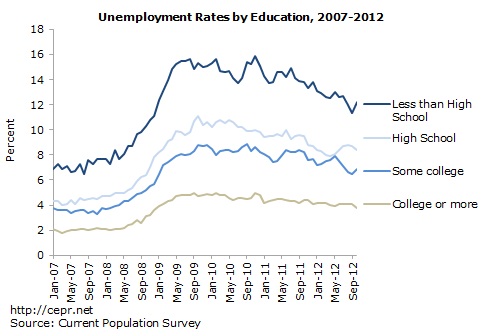November 02, 2012
November 2, 2012 (Jobs Byte)
By Dean Baker
White men have been big winners in the last year with a drop of 1.2 percentage points in their unemployment rate.
The establishment survey added 171,000 jobs in October. This increase coupled with sharp upward revisions to the prior two months of data brought the average over the last three months to 170,000. In spite of this increase, the unemployment rate slipped up to 7.9 percent, reflecting the fact that the September drop was an aberration. Even with this rise in the unemployment rate the employment-to-population rate (EPOP) rose to 58.8 percent, its highest level since August of 2009.
Most of the other data in the household survey was also positive. The number of people involuntarily working part-time fell by 269,000 reversing most of the September rise. The number of discouraged workers was 154,000 below its year-ago level, continuing its recent pattern. The percentage of unemployment due to people who voluntarily quit their jobs, a key measure of workers’ confidence in their labor market prospects, rose to 8.3 percent. With the exception of the 8.7 rate reported in March, this is the highest share since December of 2008.
By demographic group, white men have been the biggest gainers in the last year. Their unemployment rate fell from 7.8 percent a year ago to 6.6 percent in the October data. Their EPOP rose from 68.1 percent to 68.7 percent. White women also saw a substantial drop in their unemployment rate over the last year, from 7.0 percent to 6.3 percent, but this was accompanied by a small decline in their EPOP from 55.1 percent to 54.9 percent.
The unemployment rate for black men over the last year fell from 16.0 percent to 14.1 percent, while their EPOP rose from 57.5 percent to 58.1 percent. The unemployment rate for black women fell more modestly from 12.6 percent to 12.4 percent, but their EPOP rose by 0.9 percentage points, from 55.0 percent to 55.9 percent. The unemployment rate for Hispanics fell from 11.4 percent to 10.0 percent over the last year while their EPOP edged up from 59.3 percent to 59.7 percent.
By educational attainment, college grads saw a drop in their unemployment rate, from 4.1 percent to 3.8 percent. However, this was accompanied by a fall in their EPOP from 72.8 to 72.5 percent. The unemployment rate for college grads is still nearly twice its pre-recession level.

On the establishment side, all the job growth came from the private sector, which added 184,000 jobs. The private sector has added 1,963,000 jobs over the last year. The big job gainers in October were retail trade, which added 36,000 jobs; health care with a gain of 30,500; and restaurants, which added 22,900 jobs. The October gains in retail, coupled with sharp upward revisions to the prior months’ data bring the average gain over the last three months to 27,000. Job growth in health care has averaged 29,000 over this period, slightly higher than the 25,000 average over the last year. Restaurants have added an average of 34,000 jobs over the last three months.
Manufacturing added 13,000 jobs in October, after two months of decline. Similarly, employment services added 15,800 jobs, largely reversing a September drop. Construction added 17,000 jobs, a relatively big rise after four months of small gains. It is still below its April level
The average hourly wage has risen at just a 1.4 percent annual rate over the last three months. This is a bit slower than the 1.6 percent rate of wage growth over the last year. At best, wages are on average keeping even with the rate of inflation.
On the whole the data in the October report, together with the upward revisions to the prior two months’ data, show a somewhat brighter picture of the labor market. It appears that the economy is sustaining a rate of job growth in the range of 160,000-180,000 a month. This is consistent with a modest rate of decline in the unemployment rate. Nevertheless, with the economy still down by more than 9 million jobs from its trend level of unemployment, this rate of job growth implies that we would not reach full employment until the end of the decade.






